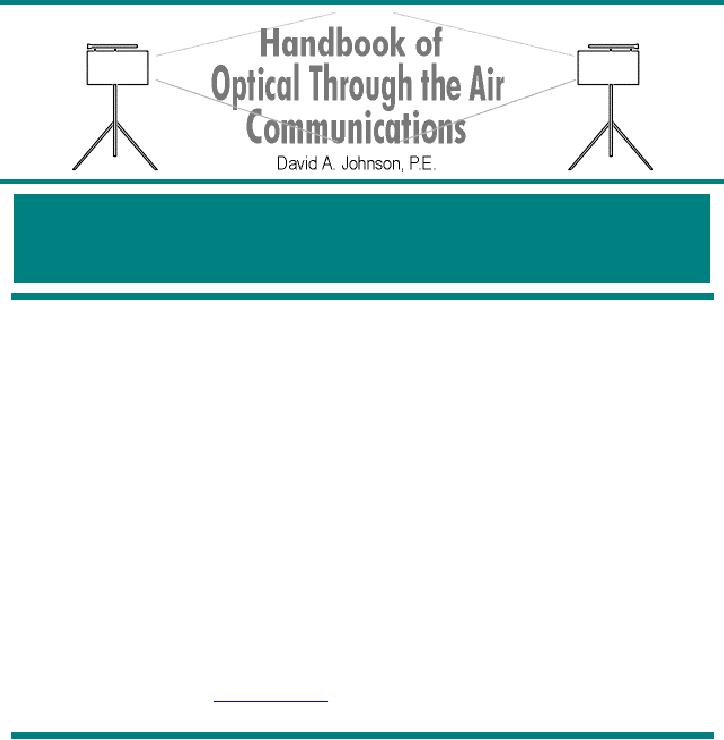 |
Preface:Table of Contents, Introduction, Why through-the-air communications? |
| LIGHT THEORY:The Spectrum, Human Eye Response, Silicon Detector Response >> |

PREFACE
About
the author:
David
A. Johnson, P.E.
is consulting electronics engineer
with a broad spectrum of experience
that
includes
product research, design and development;
electronic circuit design; design,
building and
testing
prototypes; electro-optics; and custom
test instruments. Doing business
for more than 17
years
as David Johnson and Associates, Dave
has established himself as an electronics
engineer
who
can provide a variety of services.
His
proficiency is based on "hands-on"
experience in general engineering,
electronics and electro-
optics.
Mr. Johnson is licensed by the
State of Colorado as a Professional
Engineer; he is a
graduate
of University of Idaho and is a member of
IEEE. Holds three patents and
has four more
pending.
He
remains well informed of the
latest scientific and engineering
advancements through
independent
studies. Dave is a published author
with articles and designs in
EDN,
Electric
Design,
Midnight
Engineering and
Popular
Electronics.
He
may be reach via email at dajpe@aol.com.
I
became interested in optical
through-the-air communications around
1980. At that time I
was
doing
research in high-speed fiber
optic computer data networks
for a large aerospace
company. My
research
assignment was to produce a report
that made recommendations
for the best ways of
using
the
latest optical fiber
technologies to satisfy the
increased demands for fast
data transmission in
the
aerospace
industry. My research involved
pouring through mountains of
technical papers,
scientific
journals,
patents and manufacturer's application
notes.
As
my research progressed I began to
notice that nearly all
the optical communications
systems
described
used optical fibers. Little
was being written on the
subject of through-the-atmosphere
communications.
It seemed logical to me that
many of the techniques being
used in fiber optic
communications
could also be applied in through-the-air
communications. I was puzzled by
the
technical
hole that seemed to exist.
This lack of information started my
personal crusade to
learn
more
about communicating through-the-air
using light.
During
my studies I reviewed many of the
light communications construction
projects that were
published
in some electronics magazines. I was
often disappointed with the
lack of sophistication
they
offered and usually found
their performance lacking in
many ways. Many of the
circuits were
only
able to transmit a signal a few
feet. I thought that with a
few changes they could go
miles. I
was
determined to see how far
the technology could be pushed
without becoming impractical.
So, I
took
many of the published
circuits and made them work
better. I discovered better
ways to process
the
weak light signals and
methods to get more light
from some common light
emitters. I found
ways
to reduce the influence ambient
light had on the sensitive
light detector circuits and
I
developed
techniques to increase the
practical distance between a light
transmitter and receiver. I
also
experimented with many
common light sources such as
fluorescent lamps and xenon
camera
flash
tubes to see if they too
could be used to send
information. To my delight they
were indeed
found
to be very useful.
Today,
my crusade continues. I am still
discovering ways to apply
what I have learned and I'm
still
making
improvements. However, after
having devoted some 20 years of
work toward advancing
the
technology
I felt it was time to collect
what I have learned and pass
some of the information on
to
others.
Thus, this book was
conceived.
This
handbook may be found at http://www.imagineeringezine.com/air-bk2.html.
Page
2
of 68
Optical
Through-the-Air Communications Handbook
-David A. Johnson, PE

TABLE
OF CONTTENTS
Preface
.......................................................................................
1
Table
of Contents
......................................................................
3
Introduction:
...............................................................................
5
Brief
History
......................................................................
5
Why
Optical Communications? ....................................................
7
Why
through-the-air communications? ..............................................
7
What
are some of the limitations of
through-the-air communications? ........
7
How
can these light-beam
techniques be used? .........................................
8
Possible
uses for optical
through-the-air communications
................
8
Chapter
One LIGHT THEORY ......................................................
10
The
Spectrum, Human Eye
Response
............................................
10
Silicon
Detector Response ..............................................................
11
Units
of Light
.......................................................................
11
Light
Power and Intensity ..............................................................
13
Miscellaneous
Stuff .......................................................................
13
Chapter
Two LIGHT DETECTORS
...........................................
14
What
Does a Light Detector Do?
...............................................................
14
The
Silicon PIN Photodiode
............................................................
14
InGaAs
PIN Diode ...............................................................................
14
Typical
PIN Diode Specifications ............................................................
16
Package
..............................................................................
16
Active
Area ..............................................................................
17
Response
Time
.....................................................................
17
Capacitance
.....................................................................
17
Dark
Current
.....................................................................
18
Noise
Figure ..............................................................................
18
.......................................................................
18
Other
Light Detectors
Photo
Transistor
......................................................................
18
Avalanche
Photodiode
.............................................................
19
Photo
Multiplier Tube
.............................................................
20
Optical
Heterodyning
..............................................................
21
Future
Detectors
......................................................................
21
Detector
Noise
......................................................................
21
Minimum
Detectable Light Levels ..............................................................
22
Page
3
of 68
Optical
Through-the-Air Communications Handbook
-David A. Johnson, PE
Chapter
Three LIGHT EMITTERS
.............................................
23
Introduction
to Light Emitters
..............................................................
23
Light
Emitting Diodes
(LEDs)
..............................................................
23
GaAlAs
IR LED ................................................................................
23
GaAs
IR LED
.........................................................................
24
GaAsP
Visible Red LEDs
..............................................................
25
Solid
State Semiconductor Lasers ..............................................................
25
GaAs
(Hetrojunction) Lasers ..............................................................
25
GaAlAs
(CW) Lasers ........................................................................
26
Surface
Emitting Lasers
..............................................................
27
Externally
Excited Solid State Lasers
.....................................................
27
Gas
Lasers .........................................................................................
27
Fluorescent
Light Sources .......................................................................
29
Fluorescent
Lamps
.......................................................................
29
Cathode
Ray Tubes (CRT)
..............................................................
29
Gas
Discharge Sources
.......................................................................
30
Xenon
Gas Discharge Tubes ..............................................................
30
Nitrogen
Gas (air) Sparks
..............................................................
31
Other
Gas Discharge Sources ..............................................................
31
External
Light Modulators .......................................................................
32
Chapter
Four LIGHT SYSTEMS
CONFIGURATIONS
.................
33
Opposed
Configuration
.......................................................................
33
Diffuse
Reflective Configuration ..............................................................
34
Retro
Reflective Configuration
..............................................................
35
Chapter
Five LIGHT PROCESSING
THEORY
..........................
37
Lenses
as Antennas ................................................................................
37
Mirrors
and Lenses ................................................................................
37
Types
of Lenses
.................................................................................
37
Divergence
Angle ................................................................................
38
Acceptance
Angle ................................................................................
38
Light
Collimators and Collectors ..............................................................
38
Multiple
Lenses, Multiple Sources ..............................................................
39
Optical
Filters
................................................................................
39
Make
your own optical low-pass
filter
.....................................................
41
Inverse
Square Law ................................................................................
41
Range
Equation
................................................................................
42
Chapter
Six - OPTICAL RECEIVER
CIRCUITS
..........................
43
Light
Collector
................................................................................
43
Light
Detector
................................................................................
43
Stray
Light Filters ................................................................................
44
Current
to Voltage Converter
Circuits
.....................................................
44
High
Impedance Detector Circuit
.....................................................
44
Transimpedance
Amplifier Detector
Circuit
with
resistor feedback
............................................................
45
Page
4
of 68
Optical
Through-the-Air Communications Handbook
-David A. Johnson, PE
Transimpedance
Amplifier Detector
Circuit
with
inductor feedback
..............................................................
46
Transimpedance
Amplifier Detector
Circuit
with
limited Q feedback
..............................................................
47
Post
Signal Amplifiers
.......................................................................
48
Signal
Pulse Discriminators .......................................................................
49
Frequency
to Voltage Converters ..............................................................
49
Modulation
Frequency Filters
..............................................................
49
Audio
Power Amplifiers
.......................................................................
49
Light
Receiver Noise Considerations
.....................................................
50
Other
Receiver Circuits
.......................................................................
50
Sample
of Receiver Circuits
.........................................................
52 - 58
Chapter
Seven - OPTICAL TRANSMITTER
CIRCUITS
.................
59
Audio
Amplifier with
Filters
..............................................................
59
Voltage
to Frequency Converters ..............................................................
59
Pulsed
Light Emitters
.......................................................................
60
Light
Collimators ................................................................................
60
Multiple
Light Sources for Extended
Range
............................................
61
Wide
Area Light
Transmitters
..............................................................
63
Wide
Area Information Broadcasting
.....................................................
63
Samples
of Transmitter Circuits ...........................................................
65-66
Page
5
of 68
Optical
Through-the-Air Communications Handbook
-David A. Johnson, PE

INTRODUCTION
Brief
History
Communications
using light is not a new
science. Old Roman records indicate
that polished metal
plates
were sometimes used as mirrors to
reflect sunlight for long
range signaling. The U.S.
military
used
similar sunlight powered devices to
send telegraph information
from mountain top to
mountain
top
in the early 1800s. For
centuries the navies of the
world have been using and
still use blinking
lights
to send messages from one
ship to another. Back in
1880, Alexander Graham
Bell
experimented
with his "Photophone" that
used sunlight reflected off
a vibrating mirror and a
selenium
photo cell to send telephone
like signals over a range of 600
feet. During both world
wars
some
lightwave communications experiments
were conducted, but radio
and radar had more success
and
took the spotlight. It
wasn't until the invention
of the laser, some new
semiconductor devices
and
optical fibers in the 1960s
that optical communications
finally began getting some
real
attention.
During
the last thirty years great strides
have been made in
electro-optics. Lightbeam
communications
devices are now finding
their way into many
common appliances, telephone
equipment
and computer systems. On-going defense
research programs may lead to
some major
breakthroughs
in long range optical communications.
Ground-station to orbiting satellite
optical
links
have already been
demonstrated, as well as very
long range satellite to
satellite
communications.
Today, with the recent
drop in price of some
critical components,
practical
through-the-air
communications systems are now
within the grasp of the
average experimenter. You
can
now construct a system to
transmit and receive audio,
television or even high
speed computer
data
over long distances using
rather inexpensive
components.
Why
Optical Communications?
Since
the invention of radio more
and more of the electro-magnetic
frequency spectrum has
been
gobbled
up for business, the military,
entertainment broadcasting and telephone
communications.
Like
some of our cities and
highways, the airwaves are
becoming severely overcrowded.
Businesses
looking
for ways to improve their
communications systems and hobbyist
wishing to experiment
are
frustrated
by all the restrictions and
regulations governing the
transmission of information by
radio.
There
is simply little room left
in the radio frequency
spectrum to add more
information
transmitting
channels. For this reason,
many companies and individuals are
looking toward light
as
a
way to provide the needed
room for communications
expansion. By using modulated
light as a
carrier
instead of radio, an almost limitless,
and so far unregulated, spectrum
becomes available.
Let
me give you an example of
how much information an
optical system could
transmit. Imagine a
single
laser light source. Let's say it is a
semiconductor laser that emits a
narrow wavelength
(color)
of
light. Such devices have
already been developed that
can be modulated at a rate in excess of
60
gigahertz
(60,000MHz). If modulated at a modest
10GHz rate, such a single
laser source could
transmit
in one second: 900 high density floppy
disks, 650,000 pages of text, 1000
novels, two 30-
volume
encyclopedias, 200 minutes of high
quality music or 10,000 TV
pictures. In less than
12
hours,
a single light source could
transmit the entire contents
of the library of congress. Such
a
Page
6
of 68
Optical
Through-the-Air Communications Handbook
-David A. Johnson, PE
modulation
rate has the capacity to
provide virtually all of the
typical radio, TV and
business
communications
needs of a large metropolitan
area. However, with the
addition of more
light
sources,
each at a different wavelength
(colors), even more
information channels could be
added to
the
communications system without
interference. Color channels
could be added until
they
numbered
in the thousands. Such an
enormous information capacity
would be impossible to
duplicate
with radio.
Why
through-the-air
communications?
One
of the first large scale
users for optical
communications were the
telephone companies. They
replaced
less efficient copper cables
with glass fibers (fiber
optics) in some complex long
distance
systems.
A single optical fiber could
carry the equivalent
information that would
require tens of
thousands
of copper wires. The fibers
could also carry the
information over much longer
distances
than
the copper cables they replaced.
However, complex fiber optic
networks that could bring
such
improvements
directly to the small
business or home, are still
many years away. The
phone
companies
don't want to spend the
money to connect each home
with optical fibers. Until
fiber optic
networks
become available, through-the-air
communications could help
bridge the gap. The
term
"the
last mile" is often used to
describe the communications
bottleneck between the
neighborhood
telephone
switching network and the
home or office.
Although
light can be efficiently injected
into tiny glass fibers
(fiber optics) and used like
copper
cables
to route the light
information where it might be
needed, there are many
applications where
only
the space between the
light information transmitter and
the receiver is needed. This
"freespace"
technique
requires only a clear
line-of-sight path between
the transmitter and the
distant receiver to
form
an information link. No cables
need to be buried, no complex
network of switches and
amplifiers
are needed and no right-of-way
agreements need to be made
with landowners. Also,
like
fiber
optic communications, an optical
through-the-air technique has a
very large
information
handling
capacity. Very high data
rates are possible from
multiple color light sources. In
addition,
systems
could be designed to provide
wide area communications,
stretching out to perhaps
ten to
twenty
miles in all directions.
Such systems could furnish a
city with badly needed
information
broadcasting
systems at a fraction of the cost of
microwave or radio systems, and all
without any
FCC
licenses required.
What
are some of the limitations of
through-the-air
communications?
The
main factor that can
influence the ability of an
optical communications system to
send
information
through the air is weather.
"Pea soup" fog, heavy
rain and snow can be severe
enough
to
block the light path and
interrupt communications. Fortunately,
our eyes are poor
judges of how
far
a signal can go. Some
infrared wavelengths, used by
many of the light
transmitters in this
book,
are
able to penetrate poor weather much
better than visible light.
Also, if the distances are
not too
great
(less than 5 miles), systems can be
designed with sufficient
power to punch through
most
weather
conditions. Unfortunately, little
useful information exists on
the true effects weather
has on
long-range
optical systems. But, this
should not be a hindrance to
the development of a
through-the-
air
system, because there are
many areas of the world
where bad weather seldom
occurs. In
addition,
it would be a shame to completely
reject an optical communications
system as a viable
alternate
to radio solely due to a few
short interruptions each
year. Even with present day
systems,
TV,
radio and cable systems are frequently
interrupted by electrical storms.
How may times
has
your
cable or TV service been interrupted due
to bad weather? I think the
advantages that
through-
the-air
communications can provide outweigh
the disadvantages from
weather.
Page
7
of 68
Optical
Through-the-Air Communications Handbook
-David A. Johnson, PE

Another
limitation of light beam
communications is that since light
can't penetrate trees, hills
or
buildings.
A clear line-of-sight path
must exist between the
light transmitter and the
receiver. This
means
that you will have to
position some installations so
their light processing hardware
would be
in
more favorable line-of-sight
locations.
A
third limitation, one that is
often overlooked, is the
position of the sun relative
to the light
transmitter
and receiver. Some systems may
violate a "forbidden alignment"
rule that places
the
light
receiver or transmitter in a position
that would allow sunlight to
be focused directly onto
the
light
detector or emitter during
certain times of the year.
Such a condition would
certainly damage
some
components and must be avoided.
Many installations try to
maintain a north/south
alignment
to
lessen the chance for sun
blindness.
How
can these light-beam techniques be
used?
I
believe that optical
through-the-air or "Freespace"
communications will play a significant
role in
this
century. Many of you are
already using some of this
new technology without even
being aware
of
it. Most remote control
devices for TVs, VCRs and
stereo systems rely on pulses of light
instead
of
radio. Many commercially
available wireless stereo
headphones are using optical
techniques to
send
high quality audio within a
room, giving the user
freedom of movement. In addition,
research
is
on going to test the feasibility of
using optical communications in a
variety of other
applications.
Some
military research companies are
examining ways to send data
from one satellite to
another
using
optical approaches. One such
experiment sent data between
two satellites that were
separated
by
over 18,000 miles.
Space agencies are also
exploring optical techniques to
improve
communications
to very distant space probes.
Some college campuses and
large business
complexes
are
experimenting with optical
through-the-air techniques for
high-speed computer networks
that
can
form communications links
between multiple buildings.
Some military bases, banks
and
government
centers are using point-to-point
optical communications to provide
high speed
computer
data links that are
difficult to tap into or interfere
with. But, don't become
overwhelmed,
there
are many simple and
practical applications for
you experimenters. Several
such applications
will
be covered in this handbook.
Below are some examples of
existing and possible future uses
for
light-beam
communications.
POSSIBLE
USES FOR OPTICAL THROUGH-THE-AIR
COMMUNICATIONS
Short
Range Applications
Industrial
controls and monitors
�
Museum
audio; walking tours,
talking homes
�
Garage
door openers
�
Lighting
controls
�
Driveway
annunciators
�
Intrusion
alarms
�
Weather
monitors; fog, snow, rain
using light back-scatter
�
Traffic
counting and monitoring
�
Animal
controls and monitors; cattle guards,
electronic scarecrow
�
Medical
monitors; remote EKG, blood
pressure, respiration
�
Page
8
of 68
Optical
Through-the-Air Communications Handbook
-David A. Johnson, PE

Long
Range Applications
Deep
space probe communications; distances
measured in light-years
�
Building
to building computer data
links; very high data
rates.
�
Ship
to ship communications; high
data rates with complete
security.
�
Telemetry
transmitters from remote
monitors; weather,
geophysical.
�
Electronic
distance measurements; hand held units
out to 1000 ft.
�
Optical
radar; shape, speed,
direction and range.
�
Remote
telephone links; cheaper
than microwave
�
Wide
Area Applications
Campus
wide computer
networks
�
City-wide
information broadcasting
�
Inter-office
data links
�
Computer
to printer links
�
Office
or store pagers
�
Systems
for the hearing impaired;
schools, churches,
movies
�
Cloud
bounce broadcasting
�
Page
9
of 68
Optical
Through-the-Air Communications Handbook
-David A. Johnson,
PE
Table of Contents:
- LIGHT THEORY:The Spectrum, Human Eye Response, Silicon Detector Response
- LIGHT DETECTORS:The Silicon PIN Photodiode, Active Area, Response Time
- LIGHT EMITTERS:Light Emitting Diodes (LEDs), Solid State Semiconductor Lasers
- LIGHT SYSTEMS CONFIGURATIONS:Opposed Configuration, Diffuse Reflective Configuration
- LIGHT PROCESSING THEORY:Lenses as Antennas, Light Collimators and Collectors
- OPTICAL RECEIVER CIRCUITS:Current to Voltage Converter Circuits, Post Signal Amplifiers
- OPTICAL TRANSMITTER CIRCUITS:Audio Amplifier with Filters, Pulsed Light Emitters